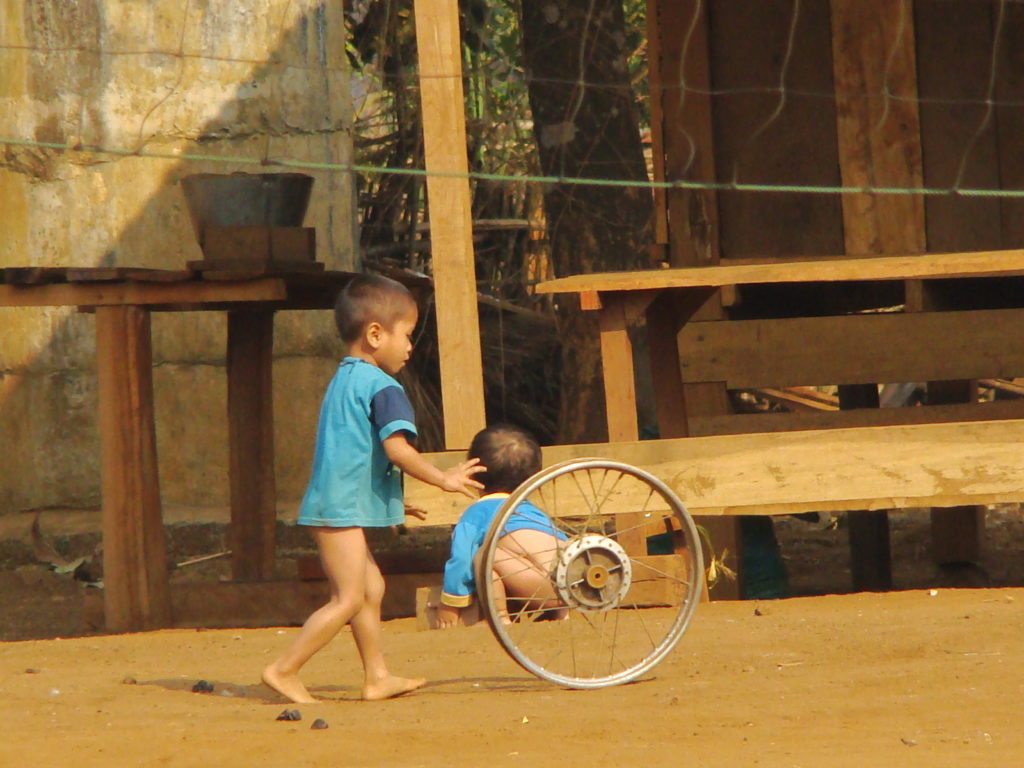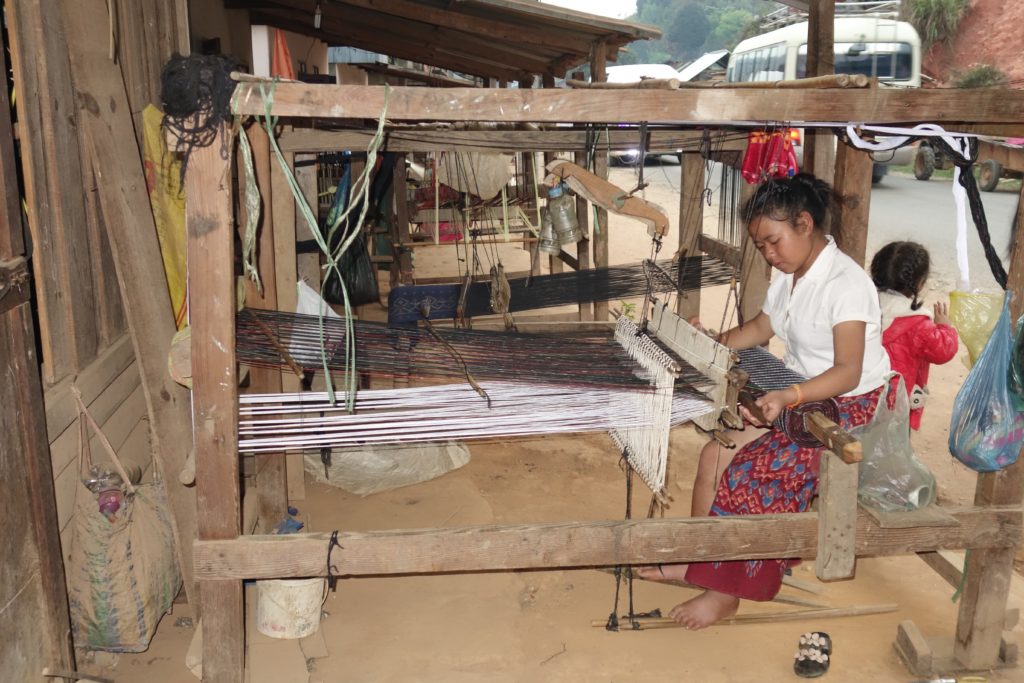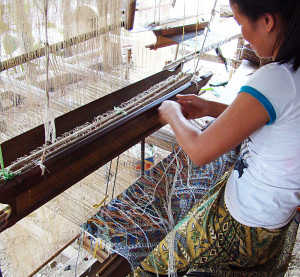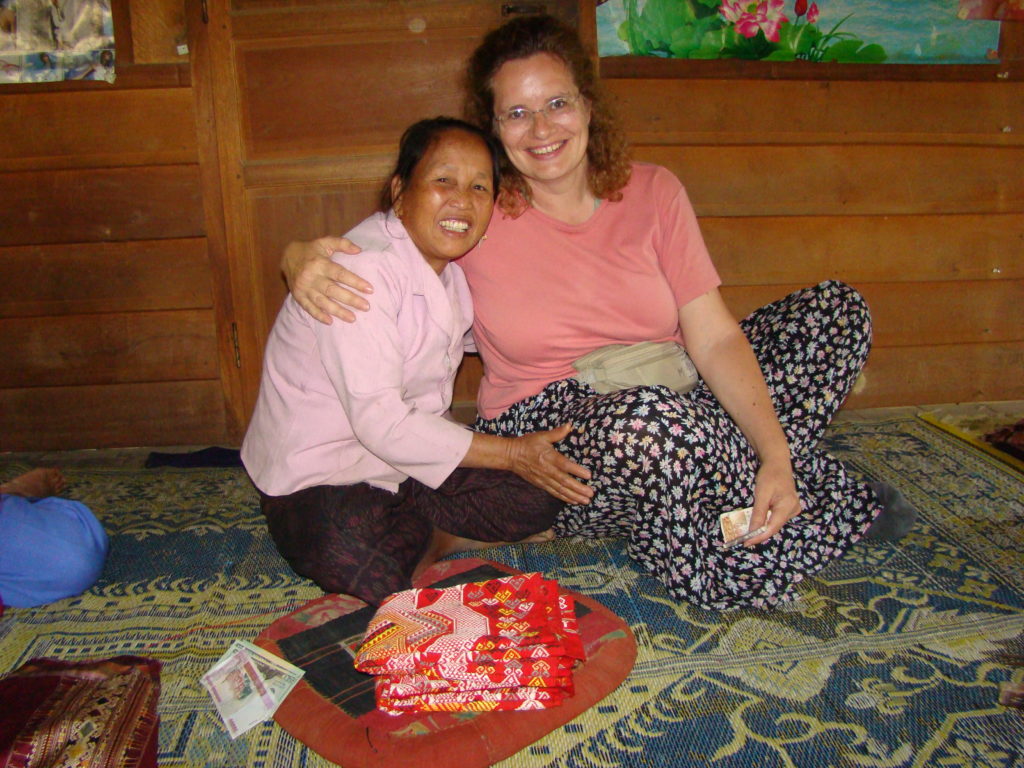from Silk Weavers of Hill Tribe Laos: Textiles, Tradition and Well-Being, by Joshua Hirschstein and Maren Beck (Thrums Books, 2017)
We each weave a life, don’t we?
I sit on the worn bench;
the shuttle passes left, then right, like a pendulum.
I weave the tasks I did not know I had chosen.
How many of us weave from cradle to grave,
never mindful of the growing cloth?
Chapter 1: Welcome to Xam Tai
Two small boys, one naked and one wearing only a t-shirt, ran blindly towards us laughing. They each held a stick and they were taking turns whapping a bicycle tire frame to continue it on its bumpy path. Looking up from their game, they saw us four falang– Maren, myself and our 12 and 9 year-old sons, Ari and Zall – and they both stopped mid-stride. The tire itself rolled forward another 20 feet, directly into Maren’s outstretched hand. She smiled: “Sabaidee,” she greeted.
The two little boys stood still for a moment, and then one turned and fled back to safety. The other stood wide-eyed, frozen. An older boy, dressed for school in a white shirt and dark pants, now saw us as well and shouted something that thawed the toddler. The little boy looked back at the shouter, then at us, then turned and ran in the direction of his original playmate
The older boy, wearing a broad smile, trotted towards us; before he had reached our side, he blurted ou,t as one long word: “Hellowhatisyourname?”
“My name is Maren,” enunciated Maren slowly. “What is your name?”
“Ma-ren,” he repeated, then: “MynameisBoun. Gladtomeetyou.“ He turned to Ari, extended a hand, and repeated: “Hellowhatisyourname?”
Before Ari could answer, another boy came running up shouting ”Hellowhatisyourname?” Ari pronounced his name for both, and then each boy asked Zall his name. Zall’s “z” sound proved a challenge and the boys smiled as they tried to turn a buzzing “zhhhh” into a delicate “zzzz.” We all laughed at the bee-hive sounds.
Two more children joined. Everyone wanted a turn with “Hello what is your name?” and we were finally rescued from the lengthy introductions when a woman emerged from the nearest home tightening her sinharound her waist.
“Sabaidee,” Maren nodded towards the woman, pressing her hands quickly together under her chin in the traditional greeting.
“Sabaidee,” the women returned with a bright smile and a casual bow and hand-press. She pointed to our two blond boys and says something that made the gathered children laugh.
Our guide and translator, Kaiphet, quickly stepped up from behind us, introduced us, and inquired as to whether there were any weavers in the village. We had read in travel books about the traditional silk and cotton weaving of Laos’ Houaphon Province, and we had seen samples of the quality weaving in the Laos’ major hub, Luang Prabang. We had also seen outlines of looms under many homes as we had approached Xam Tai on the bus.
The woman nodded and pointed to a bench in the shade under her home. With a wave of her hand, she invited us to sit on the smooth-worn benches under the home; we waited patiently as Kaiphet and the woman exchanged what we assumed were pleasantries. To our left sat a dusty wooden plow and a stack of aged cracked hardwood boards. On the right were several wide, handwoven baskets, each covered with a section of decaying brown tarp.
We had arrived in Xam Tai, in the southern section of Houaphon Province in NE Laos, at 3 PM after a 7-hour bus ride from Xam Neua over the twisty jungle mountains. We had deposited our packs in a cement box of room in the town’s sole guesthouse, and – what else to do? – walked the half hour beyond the central market and the bus station, past where the paved lane ended. The rutted dirt road, far more suited for the motorcycle than the rare four-wheel-drive vehicle, tumbled over a hillock and brought us to old Xam Tai’s several dozen homes, the older residential area. One main road cut down the neighborhood’s center; raised-stilt homes, a few with thatched roofs but most with metal, lined both sides. More homes straddled a thin, rutted lane behind the front row of houses.
Surrounding us were dusty browns and tans, from the house’s aged wooden posts to the unfinished crude boards of the houses’ siding to the thick dry roof thatch. A band of the close-by forest’s deep jungle green edged the periphery. The sky was hazy blue.
The woman stood up, re-tightened her faded cotton sinh, and beckoned us to join her around behind the stack of lumber to what looked like a four-post canopy bed; she shoed a couple chickens off a worn stained sheet that covered a structure that looked like something that might hold a narrow mattress; she pulled off the dust-cover.
The complex four-posted loom apparatus was strung with a dizzying, seemingly chaotic array of brown string, pink plastic ties and smooth-worn sticks. The extended warp, which wrapped across, up and over the loom, glowed with rich red. A glimmer of supplemental color – a bit of purple and yellow – danced a hint of expression on the front bar of the loom; the rest of the completed textile was hidden, as it had been rolled tightly during the weaving process with the bottom-side up onto the loom’s rolling front bar.
The woman disconnected the front bar and delicately unrolled the completed 3-foot section, making sure not to create excess tension on the still connected warp threads. With a smile she backed up so we could see the textile she had in progress.
The silk shimmered like a jewel – a burst of opulence and intricacy and precision in reds and yellows and purples that reached deep and sure. The bold Escher-esque geometric design – Was this an elephant? Was this a man standing? Was this the rice awaiting harvest? – defied the “simple-ness” of our surroundings.
We look closer. A thousand – no, a hundred-thousand – threads of spirited color has been cajoled and tamed into a woven dance of the exquisite and refined.
“Please, show us how?” Maren asked in English. No translation was needed.
The woman sat down on the worn bench, re-rolled the textile onto the bar, adjusted a plastic tie attached to the comb, lifted a wide set of threads with a wooden weaver’s sword, and passed her hand-smoothed shuttle between the threads, adding another line of red weft. We sat mesmerized for several minutes, watching her pass the shuttle across the warp, and then hand-pick a selection of bright silk threads across each weft row.
Two more women who must have heard Maren’s “ooo’s and ahhh’s” appeared on the porch above and leaned over the narrow wooden railing. We looked up and smiled. “Sabaidee.”
“Sabaidee-ee,” they smiled back, also holding the last long-e tone an extra beat. One of them said something and the weaver broke into a bright grin. The weaver didn’t miss a beat, continuing to work her hands, methodically picking the discontinuous supplemental color-threads into the textile’s exposed backside. Three young, bottom-naked children appeared from the home and clung to the two women’s knees, staring down at us from the overhead porch.
Ari, our 14 year-old son, offered them a wide grin; the three little boys stared. One pointed and said “Falang.” The other little boys quickly repeated: “Falang, falang!” Ari nodded at their welcome, which literally means “French,” but today refers to any westerner. Zall, our 11 year-old, raised his ever-present Nikon and snapped a shot of the boys clinging to their mothers’ legs.
Maren leaned down close to the woman’s loom to study its intricacies. The weaver kept working, knowing she was being studied. Two more children, perhaps 9 or 10 years olds in grubby t-shirts, sagging shorts and flip-flops, ran over to join the growing crowd, bringing with them a dog and a whirl of dust. A chicken with a fleet of chicks scurried by our feet and ran out of the cool of the home’s shade.
“What is she weaving?” we ask Kaiphet. Kaiphet translated the sentence into Lao and received a 3 sentence reply, and then turned to us.
“She say it is for a…uh… ceremony,” translated Kaiphet. His brow crinkled as he searched for the best words. “It is phaa sabai, but, uh, I do not know how to say in English –it is a clothing for a…a…a ‘getting better.’” He paused. “She says this style in her tradition is to … uh … how to say … to fix a balance that is inside” – and here Kaiphet put a hand on his heart. He paused again. “She… uh… says she has been weaving this piece since the end of rice harvest – about 2 months.””
The woman continued to weave on the large floor-loom, sending her worn wooden shuttle back and forth on the silk warp threads. Another older woman appeared from a home behind the first; in her left hand she held a few folded textiles. She said something quick and sharp to the two boys, and one dashed off towards where the elder had come from. An older girl brought out a plastic pitcher of water and three glasses, and we all shared a turn refreshing ourselves.
Two more people arrived – a toothless bent man wearing black-framed glasses and a young woman with an empty a backpack basket who appeared art least 9-months pregnant. They stood off to the side, joining the now-dozen children, and watched intently.
Maren had a flood of questions, and Kaiphet did his best:
The silk? – “Raised here in the baskets woven by her father, under these tarps. Here, take a look….”
The threads? – “Hand-reeled by her aunt, who lives over there….”
The colors? “All made from the forest – the dyer lives by the bus station…”
The pattern? – “This one was shaped by her grandmother and has been woven many times…”
The weaver? – “Her mother, this woman over here, taught her to weave when she was 7 years old… “
Other women and children gathered to watch and listen, and a couple older men, and another pitcher of water appeared. They smiled between themselves as they listen to our strange words, then our translator’s struggling enunciation, and finally the weaver’s concise answer.
A stack of silk textiles appeared, and another woman unfolded a creation and held it up to her chest so we could see the full dance of her phaa sabai. A bevvy of sharp-angled two-headed serpents dove through each other, purple over gold, in a sea of shimmering green and maroon. Maren and I laughed at the beauty and movement.
Maren asked a few more questions through Kaiphet, but the more detailed information Maren sought about the source of the silk and the meaning of the pattern proved the limit of Kaiphet’s English. Kaiphet looked a bit embarrassed. “No problem,” Maren said to him, “Bo penyang.” Kaiphet smiled at the Lao expression.
“Does she have any textiles for sale?” asked Maren, eyebrows raised. Kaiphet translated and the weaver nodded and turned her head upward toward the two women on the porch. She rattled off a paragraph of information. One dashed inside, we presumed to get whatever she might have for sale. The boy who had earlier dashed into the home brought out two cheap blue plastic chairs and nodded for Maren and me to sit down.
Our boys, sensing another hour at this home, sighed, and looked around at the 15 or so kids who surrounded them. Ari dug into his daypack and pulled out a frisbee. “Come on, Zall.” The two dashed out onto the main track. The local boys watched Ari and Zall toss the frisbee three times, and then the fourth time Ari zipped the frisbee to the boy who brought us a chair. The boy ducked and laughed, then ran after the crashed frisbee and attempted his first ever frisbee toss. Everyone laughed and ran to where the frisbee had landed. Maren and I knew that every boy 14 and under would be entertained for at least half an hour.
Two more women arrived along with several more children who looked anywhere between 3 and 12 years old. The boys ran to join the new-found game; the girls gathered around their moms’ legs and the loom. A moment later three more women came scurrying around from the road. There must now have been 20 people crowded around, not counting the dozen boys playing frisbee out in the road.
Then a bustling, weathered woman charged in shouting what sounded like instructions to all of us. Slung across her shoulders was an old worn purse so large that she almost could have fit into it herself; stuffed into the bag was a jumble of hastily folded rich-colored textiles. I think I actually heard Maren smile.
The short pugilist of a woman grabbed a silk from her purse and shook it at Maren. She shouted a few sentences – two women looked down sheepishly, and another laughed behind her hand. The original weaver returned, carefully clutching several neatly folded shimmering silks. She presented the stack to Maren with two hands and a little bow, and then stepped back, glancing at the elder.
The older woman scowled and spat out another couple sentences. The second woman laughed again under her breath, which inspired the sour-looking elder to throw out a few more quick lines. Kaiphet chose not to translate her words; we chose not to ask.
Maren picked up one of the original weaver’s silks and unfurled the opulent body-height tapestry. Rich gold threads, highlighted with sparks of deep green and blue, detailed the popular siho(mythical elephant-lion) motif. Ancestor figures, each riding the siho’s back, shimmered in the sun. Maren took her time to admire the piece with her eyes and hands, chortling subtle “oooohs” and other under-the-breath accolades at the complex artistry.
The elder, eyes blinking rapidly, waited perhaps 5 seconds, and she shook out one of her textiles and pushed it into Maren’s hands. She spoke in a rushed high tone. No translator was needed to tell us what she wanted.
Maren politely directed the elder’s textile to the side, all the while nodding and smiling. As politely as possible, Maren ignored the elder’s interuption and addressed the original weaver: “Sii tomasat? Sii chemi?” (“Natural color? Chemical color?”)
“Sii tomasat!”the woman grins, surprised at Maren’s Lao. The elder threw out another couple quick lines – one of the words was tomasat– and then she burst out laughing. The other woman all smiled.

The cover of our publication, available (autographed!) at www.hilltribeart.com or your favorite bookstore.
“Mai Lao? Mai Viet?”Maren continues (Lao silk? Vietnam silk?). The elder pushed a second textile at Maren, and Maren continued to ignore her, directing her full attention on the original weaver.
“Mai Lao,”the woman answered proudly. She then rattled a sentence off to Maren, who turned to Kaiphet.
“Sorry,” said Kaiphet, who was watching the frisbee game. And he turned to the woman and asked her to repeat. He laughed. “She says you speak good Lao.”
The elder grabbed a third textile from her purse and held it directly in Maren’s vision. Maren turned toward the scowling woman and explained in English, and a flurry of hand signals, that while she would get a turn, but that we were currently talking with this other woman. Kaiphet didn’t translate Maren’s words, but he does say something short that gets everyone, save the elder, to crack a smile. The elder, unperturbed, yanked now a fourth textile from her purse and held it up to Maren. Maren and she locked eyes.
The elder squinted, and pushed up her lower lip to form a deep frown. She held her grim, sour mouth in a deep frown firmly for a moment, as if daring Maren. And then, finally with Maren’s full attention, she erupted into a wide smile.
Grinning there in front of all the other women and Maren on that first day, Sukkhavit – for that is the elder’s name – held that clutched textile up for Maren to see. The women all paused, waiting to see how the stand-off would end. Maren raised her eyebrows at Sukkhavit, and then she too joined the wide grin. Sukkhavit chortled as if a great secret had been shared – and maybe it had. She reached up and shook Maren by the shoulder, as if waking her up. Then they laughed together.
Sukkhavit didn’t let go of Maren’s shoulder.
Through Kaiphet, Maren patiently assured Sukkhavit that her silks would be also admired and, possibly, purchased. Since she had arrived after the others, we explained, it would only be appropriate that she receive our focused attention after the others. Sukkhavit scowled as she watched young Kaiphet struggle to explain and, long before he could finish, she charged off on another quick sentence. The entire group of locals tried to suppress a laugh.
Sukkhavit grimaced and coughed and threw out one-liners throughout the forty-five minutes that we examined the textiles of the others. We purchased several, and rejected several, and, because no one shared a poorly made textile, we made sure to purchase at least one piece from each woman. With everyone’s presentation came a sharp comment from Sukkhavit, most of which elicited a suppressed laugh from at least one person.
By now it was obvious that this elder was the center of village politics. She had a reputation – perhaps, indeed, a dominance – that needed to be re-stated and learned given the new social venue of having us in town. Now she was firmly in the center, in control, making untranslated comments on every piece as we unfolded it.
Finally, it was Sukkhavit’s turn.
It turned out that Sukkhavit did have some of the most flawless and dynamic silks of anyone. Every piece she presented seemed rich and deep; each carried a special lustre. They were, quite frankly, the finest we had seen yet in the region – or anywhere else for that matter.
We could tell she knew that, as well.
Sukkhavit cackled with each piece of hers we set aside to purchase. She rattled off paragraphs of talk, rarely stopping for Kaiphet to stumble through a basic decoding.
And suddenly Sukkhavit was treating Maren as if they were old friends.
Indeed, both Sukkhavit and Maren seemed to have seen that each other’s take-charge exterior masked an inner soft spot. And both had much to gain with a good relationship.
In ten minutes, we had bought nearly every silk she had in her purse. (The few we rejected were presented to us by Sukkhavit again the next day, deep in a stack of new things. If nothing else, Sukkhavit is determined.)
Ten minutes after that, all four of us, along with Kaiphet, were sitting on pillows on the deliciously cool floor of Sukkhavit’s home, a pitcher of filtered water and a bunch of tree-ripened bananas and tamarind pods in front of us.
Sukkhavit’s home is built of well-rubbed teak wood and sits on stilts 7 feet above the hard-pack dirt; steep steps lead up to the low-slung doorway. Wooden shutters from the windows are tied back to bring in day’s light and a bit of breeze. An electric fan swung slowly back and forth slowly sharing it’s breath. Like most Xam Tai homes, the room is void of furniture, save a chest where a TV and radio sit. Thin interior walls, also of wood, are covered with Lao Beer advertising posters and “beautiful young women” calendars from the last decade.
We chatted through Kaiphet for perhaps half an hour, with Sukkhavit leading the conversation. She spoke in sharp, short direct sentences – not angry, but what to me sounded terse and impatient. Her face was animated, smiling big with one response, frowning deeply with the next. She took a keen interest in our two boys and seemed extra pleased when they reached for their third banana (a young, silent niece restocking the bowl long before it was empty). She was also very interested in what we were looking for as a business, and we explained that we sought both traditional textiles and traditional craft-work, such as baskets and tools. She nodded and cut another quick line to Kaiphet.
This acerbic-sounding delivery turned out to be an invitation for all of us to join her and her family for dinner the next day with her family and other guests – come at 5 PM. It’s the moment travellers always hope for – an invitation to participate on the inside – and we cheerfully agreed.
Poor Kaiphet. At that next day’s dinner and extended evening, I have never seen someone work so hard to keep up. The event started with Sukkhavit luring us with a few more choice textiles, and we selected what made sense for our budget. Like most Lao business people we have worked with over the years, she set a firm and reasonable price for each piece; we bargained a little, and she gave just enough so we could all feel successful, but no one forgot who was truly in charge of the dealing. She then turned to a pile of other goods stacked in the corner.
Sukkhavit, always the business-woman, apparently had scurried around town all day seeking possible items for us to buy for our business. Each item she obtained came with a presentation – no, a skit – where she demonstrated its usage. And with each skit the audience, that is everyone in the room, laughed appreciatively. Here was Sukkhavit as a H’mong farmer, picking greens and tossing them into her richly-patina’d backpack basket. Here was Sukkhavit as as a Tai Daeng fisherman, stirring her small triangle net in the stream and placing the small caught fish into the creel tied onto her waist. And now here was Sukkhavit the healing shaman, dancing a hop-step and shaking her bamboo “spirit-sticks” as if in a trance (and she actually had obtained traditional scarf with bamboo “healing-sticks” attached from a local shaman).
Thankfully for Kaiphet, little translation was necessary during the presentation; laughter is understood everywhere. Sukkhavit’s husband, a kind man whose smile grows in proportion to the number of textiles purchased, passed me a shot glass of lao-lao, local rice whiskey, and he flicked his wrist in front of me to indicate I should toss it down in one gulp. I returned the empty glass and it is refilled and passed to the person next to me, and so on around the circle twice, and then again twice, everyone sharing the glass. Our boys, getting a nod from Maren and me, join the toast.
Out of the corner of my eye I caught Sukkhavit luring 11-year-old Zall over to a wooden crossbow – what kid doesn’t like a handmade weapon! We had seen many boys in the area use such tools to catch catch rodents and small birds for dinner. Sukkhavit carefully showed Zall how to hold the crossbow and then drew an 18″ arrow from a woven bamboo sheath. She pointed to a corner of the room – perhaps to where the bamboo rat was to be – and helped Zall pull the string to a tight locked position and then load the lethal weapon. Zall aimed and Sukkhavit leaned over his shoulder like an umpire behind a catcher – her eyes, as were Zall’s, trained on the target. “P-shewwww,” Sukkhavit whistled as if the arrow had been launched (and here for a moment I thought she would actually let him launch the thing). She laughed and clapped Zall on the back, and then leaned over and gave him a quick grandma-like hug. Not a word had been translated; not a meaning had been missed.
“A-li,” Sukkhavit says to Ari from across the room, and she shuffled over to him. With her hands she motioned for him to stand up. Ari got up slowly from his cross-legged position, and, as he maneuvered his feet under himself, Sukkhavit leaned back in mock amazement at his rising frame – at 14-years-old he was a full head taller than she was.
She flapped her hand ceremoniously several times as if preparing to perform a magic trick, and then she reached up and grabbed Ari’s shoulder in a firm clutch. The room turned quiet as everyone watched.
There was a moment of profound silence. She stared up at him with a faux-serious face and with her chin jutted out and cleared her throat. She ran her eyes over him from top to bottom, bottom to top, as if inspecting a soldier, or a side of beef.
She rattled off a quick couple sentences, and I can only catch the words for “son” (luk sai). The room burst into laughter, and she continued her inspection. Ari smirked, and looked a little embarrassed. A woman sitting on the floor tossed a quick line, and then more laughter, and then another said something in an undertone and everyone laughed again. Sukkhavit’s firm face finally bursts into a wide grin.
“She says…” Kaiphet smiled, and then he hesitated a moment, gathering his words. “Sukkavit says Ari is strong and handsome… and would make good husband. She asks if maybe you leave him here, and he can find a Lao wife – one who can weave well.”
Everyone watched us intently, smiling and eager, while Kaiphet translated for us, and then we all laughed together on the shared joke.
Suddenly everyone stood – “kinh, kinh”(eat, eat) ordered Sukkhavit – and the stacks of textiles and back pillows are pushed to the edges of the room. A young woman, one of Sukkhavit’s many nieces, rolled a blue fiberglass tarp about two feet wide and ten feet long onto the floor – the tablecloth. Pillows were re-distributed, Maren and me each getting two – perhaps as marks of honor, or perhaps because we bear bigger bottoms.
Out from the back-room kitchen came steaming bowlfuls of laap (minced pork with banana flower, garlic, ginger and chilli), boiled chicken (we are honored with the chicken’s head and Maren does her best with it), chicken broth with onion and garlic greens, bowls of fresh, sweet spinach-like greens, plates of steamed bamboo shoots, and several woven basketfuls of glutinous “sticky” rice. We sat cross-legged on the floor, and Sukkhavit and her family made sure that the bowls of shared food at our end of the table were refilled long before they approached empty.
Here’s a cultural tip for Laos: Don’t finish your portion. Because you can’t. An empty guest plate is the sign of a neglected guest, and you will be served food until you leave food untouched in front of yourself. Others will even politely do without to make sure you, as a guest, have too much. And don’t keep nibbling at the food once you’re full. Everyone is compelled to continue eating if a guest is still eating. Finish eating, leave leftovers, and be done. So everyone else can be done, too.
On that first evening I’m sure Sukkhavit shared about her family, but we kept no notes and we were all gabbing and striving for basic understandings …. and all relying on our dear poor 22-year-old translator Kaiphet for anything that couldn’t be mimed.
So many people were introduced – even ten years later we get faces and names mixed up, and often can’t remember who is related to whom.
After dinner we shared songs back and forth from our cultures – their beautiful and haunting Lao songs of love and friendship oddly balanced with our choice of nursery rhymes (although, in truth, singing a round of “Row, Row, Row, your Boat” went over quite well).
Heads were drooping by 9 PM – dawn arrives early every day. With a dozen good-byes and well-wishes, we don our headlamps and weave our way back, smiling, to our simple guesthouse. Kaiphet walks with us, finally able to be silent.
“I think we’ve been adopted,” Maren laughed quietly to everyone.
I could feel the smiles around.












